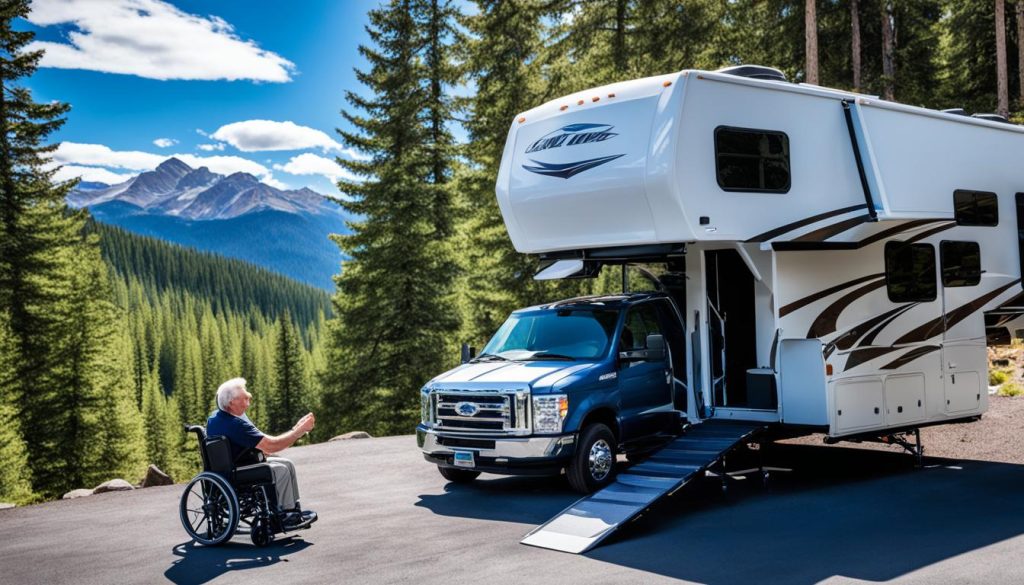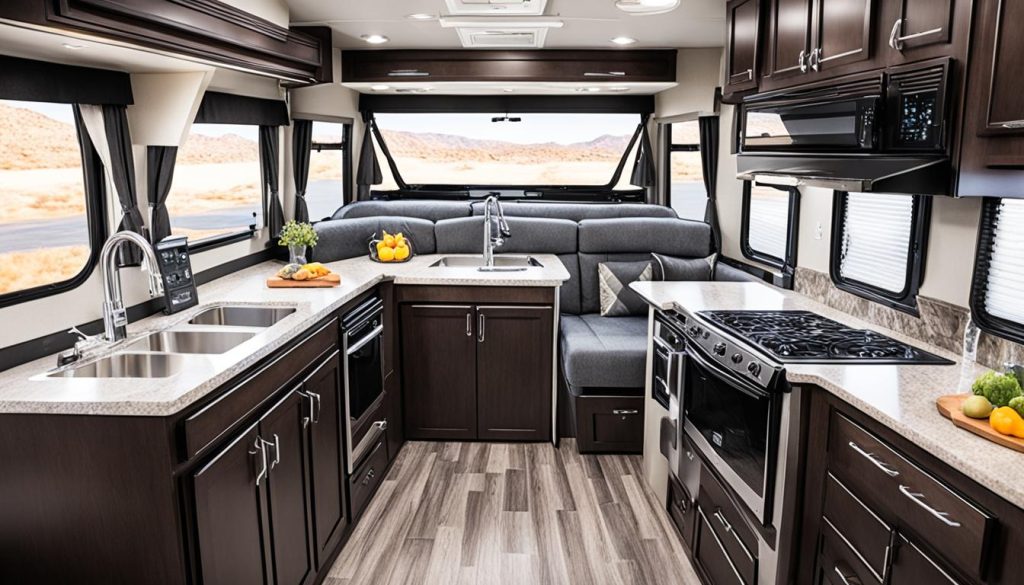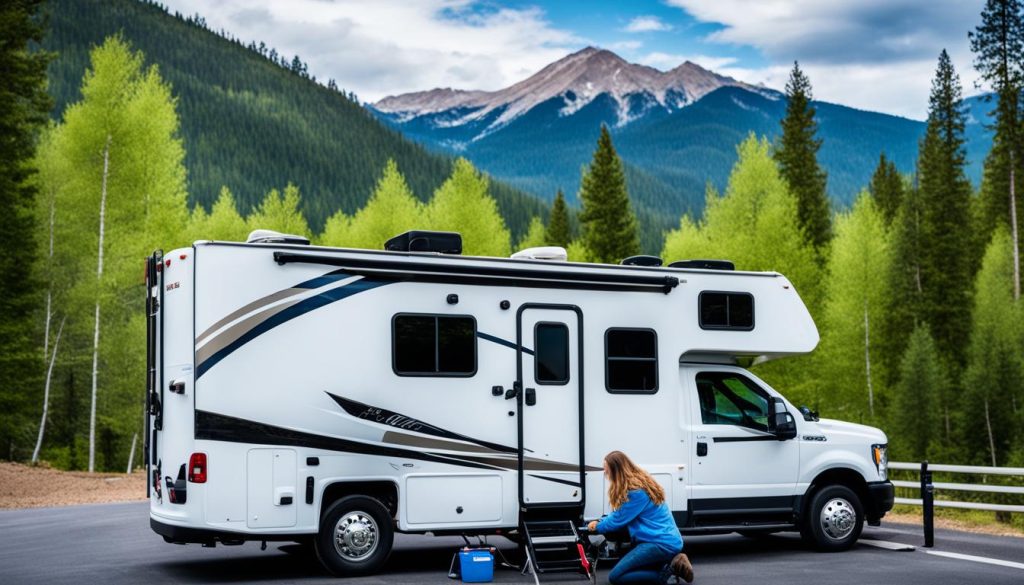Accessible RVing Tips for Disabled Travelers
gorvlifestyle.com and its partners may earn a commission if you purchase a product through one of our links
Embracing the spirit of adventure while navigating the challenges associated with disabilities, many are discovering the joys of RVing with disabilities. Accessible RV travel is transforming the landscape of outdoor recreation, creating opportunities for individuals with mobility limitations to experience the freedom of the open road without barriers. The notion of disability-friendly RVing has become a beacon of independence, offering custom modifications and innovations that cater to a range of needs, promoting comfort and autonomy.
Key Takeaways
- Adaptive RV features are vital for a barrier-free travel experience.
- Accessible RV travel promotes independence and a sense of freedom.
- Disability-friendly RVing encompasses both safety and comfort.
- RV modifications should aim for ADA compliance to ensure accessibility.
- Customized RVs enhance the overall outdoor experience for disabled travelers.
Understanding the Importance of Accessible RV Travel
The freedom to travel is a cherished ideal, and for those facing mobility challenges in RVing, that freedom has become more achievable with the growth of inclusive RV camping and handicapped-accessible RV parks. By understanding the necessity of accessible travel and the strides the industry has made, we can fully appreciate how RVing with disabilities positively reshapes the travel experiences for countless individuals.
The Rise of RVing with Disabilities in the U.S.
In recent years, there’s been a noteworthy uptick in RVing popularity among those with disabilities. The demand for accessible RV options reflects a broader societal shift towards inclusive leisure activities. This surge is mirrored by increased investments from RV parks in amenities that support the needs of all visitors, thus fostering a more welcoming environment for travelers with diverse mobility needs.
Assessing the Benefits of Inclusive RV Camping
Embracing inclusive RV camping equates to embracing a world where barriers are continually being dismantled. Handicapped-accessible RV parks aren’t just about providing a space to park; they’re about offering the same enriching connection with nature that all travelers seek. These accessible facilities are ensuring that the RV lifestyle is possible for everyone, fostering community, respect, and equity across the board.
Key Health and Satisfaction Advantages for Disabled Travelers
The distinct benefits of accessible RV travel extend beyond mere convenience. For many with disabilities, it serves as a pivotal contributor to mental and physical well-being. Safety and the ability to navigate freely within their environment allow disabled travelers to enjoy the therapeutic qualities of travel. Consequently, the autonomy and satisfaction derived from accessible camping setups have been linked with improved quality of life, underscoring the profound importance of such initiatives.
Studies underscore the value of independence for those with mobility challenges in RVing, a factor that directly correlates with higher life satisfaction and emotional well-being. Accessible travel, thus, is not a luxury—it is a vital component of an inclusive society that values all its members.
In conclusion, the growth of inclusivity in RV parks and travel options mirrors the progress in our collective consciousness about the necessity of accessibility in all facets of life. From overcoming mobility challenges to experiencing the joys of the open road, inclusive RV camping offers a pathway to freedom and joy for travelers with diverse needs.
Choosing the Right RV: Accessibility Features to Consider
The journey to selecting an RV that meets the needs of disabled individuals involves understanding the spectrum of disability-friendly RV options available. While some may opt for RV modifications for disabilities, others might find disabled-friendly RV rentals a more suitable choice. This section will delve into the various considerations that come with adapting an existing recreational vehicle as opposed to purchasing a custom model tailored for accessible needs.
Pros and Cons of Modifying an Existing RV Versus Buying an Accessible Model
Many find themselves at a crossroad when deciding whether to modify their current RV or pursue the purchase of a newly designed accessible model. On one hand, RV modifications for disabilities can provide a personalized solution that caters specifically to the user’s needs. Modifications can range from the installation of handrails and non-slip flooring to more significant alterations such as ceiling track lifts and roll-in showers.
However, the process of retrofitting can come with downsides. The costliness and complexity of certain adjustments, particularly in older models, can add up. There’s also the consideration of voided warranties or reduced resale value. In contrast, opting for a purpose-built accessible RV—though potentially more expensive—offers a turnkey solution with factory-guaranteed amenities designed to ensure safety and convenience from the start.
Comparison of Top RV Brands Offering Disability-Friendly Options
While the market for disabled-friendly RV rentals is growing, owning a personalized, adapted RV can provide unparalleled independence. Notable industry leaders like Winnebago and Newmar offer models engineered with accessibility at their core. These brands understand the unique challenges faced by disabled individuals and have committed to designing disability-friendly RV options that accommodate a wide range of disabilities.
| Feature | Winnebago Accessibility Enhanced Models | Newmar Mobility Lineup |
|---|---|---|
| Entry | Powered wheelchair lift | Hydraulic wheelchair lifts |
| Interior Navigation | Expanded hallway and bathroom areas | Extra wide aisles |
| Controls | Lowered switches and appliances | Remote-controlled systems |
| Sleeping Arrangements | Height-adjustable beds | Roll-under countertops and tables |
While these examples illustrate the commitment of such brands to inclusivity, potential buyers must consider their personal needs against what is available in the market. For some, the certainty of an on-the-lot accessible model may trump the time and effort required for custom modifications. However, the value of a perfectly tailored space that a customized RV brings can often be worth the investment for those looking for a long-term solution.
In conclusion, there is no one-size-fits-all answer to acquiring the ideal RV for those with disabilities. A balance between cost, convenience, and customization will guide the decision-making process. Regardless of the path chosen, the availability of RV modifications for disabilities, combined with the option of dedicated, disability-friendly RV rentals, means that there has never been a better time for disabled individuals to explore the freedom of the open road.
RVing with Disabilities: Preparing Your Vehicle for Accessibility
Adapting an RV for individuals with disabilities is a multifaceted process that ensures comfort and autonomy during travel. Specific RV modifications for disabilities must be implemented, focusing on incorporating adaptive equipment for RVing into the vehicle’s design. The goal is to create a hospitable environment within the RV that accommodates the necessary aids and tools required for individuals facing various mobility challenges.
To ensure that all modifications meet the essential needs of disabled travelers, ADA guidelines are referenced closely, stipulating the mandatory standards for spatial layout and feature accessibility within the RV. These modifications often include the addition of supportive features like handrails, the widening of doorways to allow for wheelchair passage, and even the employment of wheelchair lifts for ease of entrance and exit. Bathrooms are a critical area of focus, where handrails and space-converting modifications, like transitioning to a wet-room style, are not uncommon endeavors to enhance safety and convenience.
| Adaptive Feature | Description | ADA Guidelines Consideration |
|---|---|---|
| Wheelchair Lifts | Hassle-free entry and exit for wheelchair users | Proper height and lift capacity to accommodate various wheelchair types |
| Widened Doorways | Expansive entry points to facilitate movement | Minimum width requirements to allow wheelchair access |
| Handrails | Supportive aids installed in crucial areas like bathrooms and entryways | Strategic placement and strength to assist in mobility |
| Wet-Room Bathroom | Bathrooms designed without barriers to shower and floor areas | Features sloped floors for drainage and ease of cleaning |
It is imperative that these adjustments not only comply with regulatory measures but also align with the personal needs of the travelers. This often necessitates a custom-tailored approach, where attention to detail can make a significant difference in the day-to-day experience of the RVer. Robust planning and consultation with disability adaptation specialists can yield the best results, crafting a balance between meeting legal requirements and providing a genuinely user-friendly, accessible RV experience.
Adaptive Equipment for RVing: Enhancing Mobility Inside and Out
RV enthusiasts who face mobility challenges have a range of adaptive equipment options to enhance their travel experiences. Facilitating ease of movement both within and around the vehicle is critical for creating a comfortable and accessible environment. This section delves into the specific equipment and modifications designed to aid mobility for those who use wheelchairs and how they align with official standards and guidelines.
Wheelchair Lifts and Ramps: Installation and Compliance with ADA Guidelines
Incorporating wheelchair lifts for RVing is a transformative move towards inclusivity on the road. These critical enhancements adhere to ADA guidelines for RVs, ensuring that users have safe and reliable access. Compliance is more than a mere requirement; it’s a commitment to mobility freedom, with specifications that accommodate a wide array of wheelchair types while providing robust support.
The installation process for wheelchair lifts and ramps demands precision and an understanding of the user’s unique needs. These solutions must be integrated with thoughtfulness for space constraints, power supply, and user independence—factors that call for skilled craftsmanship and advanced planning.

Transforming the RV Bathroom to a Safe, Accessible Space
An accessible RV bathroom goes beyond mere comfort; it’s a necessity for a dignified experience. Combatting one of the highest risks for mobility-impaired individuals—falls in the bathroom—means outfitting this private space with aids like handrails, flat-level showers, and seats. Such equipment provides stability and a sense of security to the user.
The design of an accessible bathroom considers the ease of maneuvering a wheelchair within a limited space, the reachability of fixtures, and the slip resistance of surfaces. It is here where personal well-being connects with thoughtful design, creating a space that is both functional and a retreat.
Through the addition of these adaptive features, the RV becomes a cornerstone of opportunity—a home away from home where the open road is no longer a view from the window, but a tangible journey waiting to be explored.
Strategies for Inclusive and Accessible RV Parks and Campgrounds
As the call for inclusive RV camping experiences grows louder, park owners and developers are actively seeking out methods to transform their venues into handicapped-accessible RV parks. These inclusive environments are crucial for ensuring that individuals with disabilities can enjoy outdoor recreation alongside their peers. To cater to such needs, destinations are employing several strategies to upgrade their facilities and services.
- Conducting comprehensive audits to assess current levels of accessibility and pinpointing areas for improvement.
- Improving infrastructure to include features such as wheelchair-friendly picnic areas, restrooms, and shower facilities.
- Offering specialized training to staff on the requirements and assistance that guests with disabilities may need.
- Creating accessible outdoor recreational opportunities, such as fishing docks and nature trails that take into account the diverse range of mobility among RVers.
- Enabling online and telephone reservation systems that provide details on the specific accessibility features of each campsite.
These measures not only foster an environment of equality but also amplify the enjoyment and satisfaction that inclusive RV camping promotes. As RV parks and campgrounds transition into spaces that welcome all travellers, the spirit of freedom and adventure inherent in RV culture remains alive and vibrant for everyone.
Whether it’s a remodelled campsite equipped with the necessary facilities or new policies that prioritize inclusivity, these strategies play a pivotal role in ensuring that camping remains a feasible and delightful option for RVers with disabilities. It’s a holistic approach that benefits all involved by cultivating a friendly, supportive community that values the presence and contributions of each member, regardless of their physical abilities.
Ultimately, the goal is clear: to weave the threads of accessibility into the very fabric of outdoor leisure, creating a tapestry of travel experiences that are as diverse as they are enriching. As more RV parks and campgrounds embrace this vision, the future looks bright for accessible RV travel, paving the way for adventures that are truly limitless.
Essential RV Modifications for Disabilities: From Kitchens to Living Areas
Transforming an RV into a space that accommodates the various needs of individuals with disabilities requires mindful considerations. To elevate their RV experience, travelers can equip their mobile retreat with features that enable both independence and safety. Specifically, when addressing the kitchen and living areas, careful attention must be given to RV modifications for disabilities, which play a pivotal role in creating a homely and accessible environment.
Designing an Accessible RV Kitchen for Independence and Safety
The heart of an RV is often its kitchen, and for travelers with disabilities, an accessible RV kitchen is central to an enjoyable experience on the road. Thoughtful designs that incorporate lowered countertops and cabinets, slide-out shelving, and appliances set at reachable heights can empower users, promoting their autonomy in meal preparations and daily routines. Such alterations are more than mere conveniences; they are steps toward inclusivity and dignity. 
Here’s a closer look at some common modifications that bring empowerment to the kitchen:
| Modification | Purpose | Benefit |
|---|---|---|
| Lowered Countertops | Easier access for wheelchair users | Allows for meal prep and cooking while seated |
| Adjustable Shelves | Customizable storage | Items can be easily reached without strain |
| Front-Control Appliances | Prevent reaching over hot surfaces | Increases safety during appliance use |
| Pull-Down Cabinets | Storage access at a comfortable level | Secures items within arm’s reach |
Maximizing Comfort in Living and Sleeping Areas
Beyond the kitchen, the comfortable living areas in an RV are instrumental in providing a restful and adaptable space. Seating should not only be comfortable but also accommodate mobility aids such as transfer boards or seat lifts. Adequate spacing around furniture ensures easy movement, while beds that can be adjusted in height and firmness cater to diverse needs.
In the pursuit of comfort and function, here are key aspects to consider for a disability-friendly living and sleeping space:
- Ample clearance for wheelchairs to navigate through living areas with ease.
- Custom seating options like recliners or couches with removable arms.
- Flexible bed solutions that can be tailored for conditions like fibromyalgia or cerebral palsy.
- Use of accessible technology, such as remote control systems for lighting, entertainment, and climate control.
The right RV modifications for disabilities not only ensure safety and accessibility but also foster a sense of belonging and comfort on the road. With these tailored features in place, travelers with disabilities can enjoy a profound sense of freedom in their journeys, marked by the reassuring knowledge that their RV is a sanctuary equipped to meet their needs.
Disability-Friendly RV Rentals: What to Look for
Embarking on a journey with disabled-friendly RV rentals is not only about finding a vehicle that can take you from point A to point B; it’s about discovering a rental that can enhance your accessible RV travel experience. The savvy traveler seeking practicality and autonomy on the road needs to prioritize RVs designed with features that address mobility challenges while ensuring the utmost comfort.
Let’s break down the essential elements that make for a truly accessible RV. When you start your search for an RV rental, you should look for vehicles that go beyond the bare minimum, offering adaptations and conveniences that can make all the difference in your travels.
| Accessibility Feature | Description | Benefit |
|---|---|---|
| Wheelchair Ramps and Lifts | Sturdy, retractable ramps or electric lifts that facilitate entry and exit. | Improves autonomy for travelers, making the RV accessible without additional assistance. |
| Modified Bathrooms | Adapted features including roll-in showers, grab bars, and heightened toilet seats. | Ensures safety and independence in personal care within the private confines of the RV. |
| Accessible Kitchen Layout | Lowered countertops and appliances, and open under-sink spaces to accommodate a wheelchair. | Makes meal preparation easier and more enjoyable for guests with mobility impairments. |
When considering disabled-friendly RV rentals, verify that the rental company can demonstrate a clear understanding of the unique needs associated with accessible RV travel. Inquire about specific features or request photographs to ensure the advertised amenities align with your requirements.
Evaluating these disability-friendly RV rentals holistically will not only set the stage for a smoother journey but also provide a frame of reference should you choose to make long-term modifications to your own RV. Remember, your comfort and safety are paramount, so don’t hesitate to ask detailed questions about the accessibility features that can turn a good vacation into a great one.
Maintaining Your Accessible RV: Safety Checks and Upgrades
Maintaining an accessible RV requires close attention to safety checks and regular maintenance to ensure a secure and comfortable travel experience. Prioritizing these aspects is not only about preserving the vehicle’s condition but also about the safety and independence of its occupants.

Regular Maintenance of Wheelchair Lifts and Accessibility Features
Consistent wheelchair lift maintenance is a non-negotiable aspect of owning an accessible RV. These devices are essential for mobility and independence, which is why they require systematic inspections. A schedule for regular examinations must be adhered to, addressing any signs of wear and tear promptly to avoid malfunctions that could compromise safety.
Fire Safety and Prevention in Adapted RV Kitchens
For travelers with disabilities, fire safety in RVs is particularly crucial. Adapted RV kitchens need to be outfitted with fire suppression systems, alarms, and accessible extinguishers. Simple practices, such as keeping appliances clean and ensuring they are in good working order, form the first line of defense against potential fire hazards. RV safety checks should regularly include verification that all kitchen electronics function correctly and that the space adheres to fire safety guidelines.
Both wheelchair lift maintenance and fire safety in RVs are pillars supporting the overarching structure of accessible RV travel. Taking proactive steps in these areas ensures not only the longevity of the vehicle but also the well-being of all those who travel within it. Remember, a well-maintained RV is a safe haven on wheels.
Planning an RV Trip: Routes, Destinations, and Resources for Disabled Travelers
RV trip planning for disabled travelers should be a thorough process that offers comfort, convenience, and accessibility. The journey to finding accessible RV destinations begins with a meticulous look at each stop along the way, ensuring that all facilities and services meet the needs of those with disabilities. It’s not just about where to go, but also how to get there safely and comfortably. With the right RV travel resources, vacationing can be a stress-free and enjoyable experience for everyone involved.
Key resources include travel guides specifically designed for accessibility, user-generated content with feedback on accessible RV destinations, and apps that cater to the special requirements of travelers with disabilities. The information gleaned from these resources helps in mapping out a suitable route and in identifying the most accommodating RV parks and campsites.
| Resource Type | Description | Benefits |
|---|---|---|
| Travel Guides and Books | Comprehensive manuals listing RV parks and campgrounds with accessibility features. | Provides details on amenities, accessibility options, and reviews. |
| Online Communities | Forums and social media groups where disabled RVers share experiences and tips. | Real-life advice and personalized support from experienced travelers. |
| Mobile Apps | Applications offering navigation, reviews, and site booking for accessible travel. | Easy access to information and on-the-go booking capabilities. |
| State and National Park Information | Official websites with details on accessibility for various parks across the U.S. | Guaranteed accurate and up-to-date information on public park facilities. |
These RV travel resources create an ecosystem of support, allowing travelers to plan their journeys with confidence. From accessible rest stops to attractions that accommodate all, the possibilities for an incredible RV adventure are endless. Balancing freedom on the road with well-researched plans will result in trips that are not only memorable but also inclusive.
Remember, the goal is for everyone to savor the journey as much as the destination. Therefore, careful RV trip planning that integrates the needs of disabled travelers is paramount. Incorporating these viewpoints and insights can break down barriers, paving the way for truly accessible RV destinations that cater to travelers seeking adventure without limitations.
Making the Most of Your Accessible RV Trip: Tips for Enjoyment and Comfort
Setting out on an accessible RV trip invites adventure and relaxation, yet comfort and enjoyment are paramount for travelers with disabilities. A successful journey hinges on meticulous preparation, ensuring that all modifications—from ramps to widened doorways—meet the needs of those on board. It starts with a careful assessment of the RV to confirm that it reflects the home-away-from-home environment that is both comfortable and inclusive. The emphatic goal is to create a space where accessibility seamlessly blends with the ease of travel, allowing travelers to immerse themselves fully in the experience.
Identifying and favoring destinations that champion accessibility is equally crucial. This strategic approach not only smoothens the path but enhances the experience by minimizing the hurdles often encountered at less accommodating locations. In the spirit of inclusive RV trips, cultivating a network of fellow RVers who share mobility challenges can be a source of invaluable tips and support. By having a community on the road, travelers can exchange insights that make navigating the vast American landscapes a collective joy rather than an individual challenge.
Packing for the trip is a fine art that balances needs and wants, with a priority given to essentials that address mobility concerns and comfort. It is sensible to prepare for the unexpected, keeping a close eye on weather forecasts, route conditions, and local healthcare facilities. With these strategic tips for accessible RV travel, explorers can confidently embark on their next outing, eager to create memories that underscore the accessibility and delight of the open road. Ultimately, the journey becomes a celebration of independence, cultivating a profound sense of fulfillment and contentment with every mile traveled.

